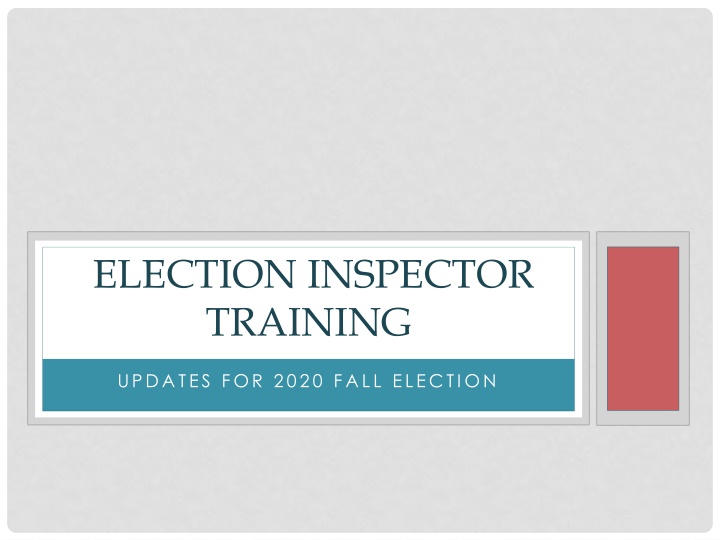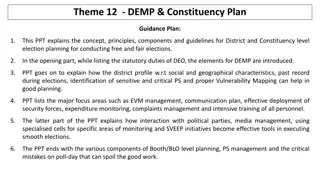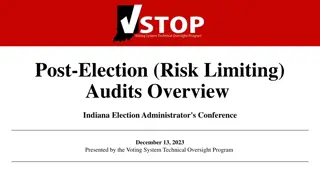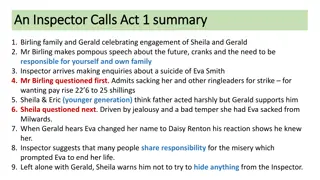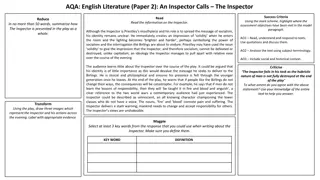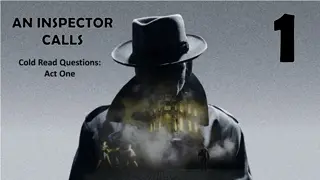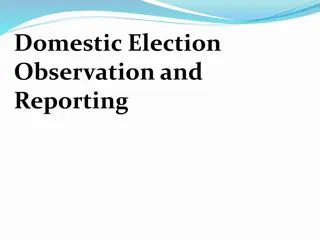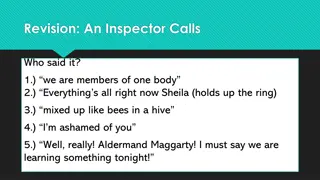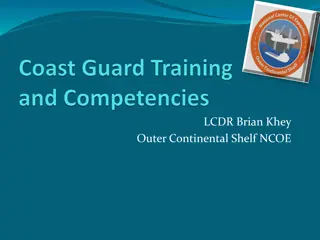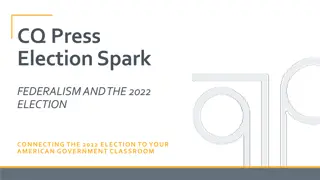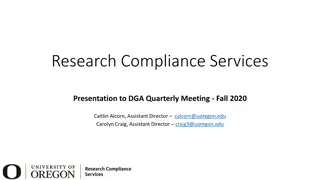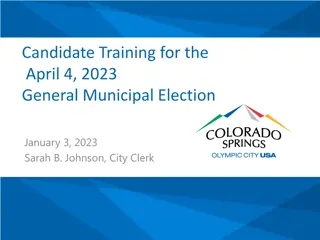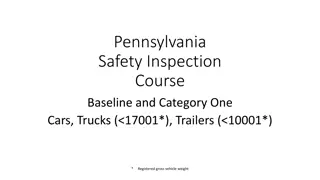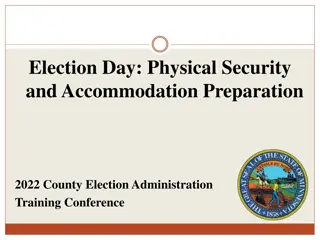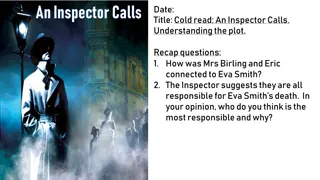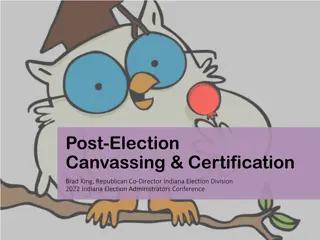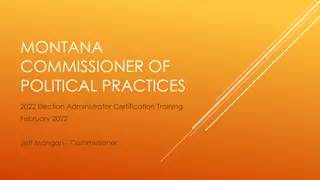Election Inspector Training Updates for 2020 Fall Election
This update provides essential information for election inspectors participating in the 2020 Fall Election. Topics include changes in residency and student ID requirements, face-covering protocols at polling places, absentee ballot deadlines, polling place procedures, inspector responsibilities, and electioneering rules. The content emphasizes the importance of staying informed as election laws and guidelines may evolve. Presented in association with the University of Wisconsin-Madison Extension and the Wisconsin Elections Commission.
Download Presentation

Please find below an Image/Link to download the presentation.
The content on the website is provided AS IS for your information and personal use only. It may not be sold, licensed, or shared on other websites without obtaining consent from the author.If you encounter any issues during the download, it is possible that the publisher has removed the file from their server.
You are allowed to download the files provided on this website for personal or commercial use, subject to the condition that they are used lawfully. All files are the property of their respective owners.
The content on the website is provided AS IS for your information and personal use only. It may not be sold, licensed, or shared on other websites without obtaining consent from the author.
E N D
Presentation Transcript
ELECTION INSPECTOR TRAINING UPDATES FOR 2020 FALL ELECTION
TRAINING INFO This information is presented by Melissa Kono, Associate Professor with University of Wisconsin- Madison Extension and Community Development Educator for Clark & Trempealeau Counties also a Town Clerk for the Town of Burnside in Trempealeau County This material was developed from information from the Wisconsin Elections Commission Please check with the Wisconsin Elections Commission and the Election Day Manual for the most recent election guidance, as laws and guidance can change
OVERVIEW Changes to Residency Requirements Changes to Student ID requirements Face coverings in polling places Absentee deadlines *Please note that these are current as of 9/29/2020. Election laws and guidance can and do frequently change. Please check for any important revisions.
POLLING PLACE PROCEDURES
INSPECTORS STATEMENT Inspector Statement needs to be filled out completely. Tamper-Evident Seal Number s must be recorded and should be checked by the Chief Inspector pre-election and post-election. Record ballot bag tamper evident seal # Record Total number of voters. Record Total number of EDRs. Record Number of absentee voters. Record number of provisional ballots. Record number of ballots cast. Record number of excess ballots.
ROLES AND RESPONSIBILITIES Your job is to facilitate democratic process, and not to act in the interest of a specific party when doing the following: The polling place must be set up to process voters by 7:00 am on Election Day. You should be ready to process voters when they arrive at the polling place. You can use cell phones, read books, crosswords, etc. when there is down time in the polling place, but you should use good judgement when doing so.
ELECTIONEERING No electioneering at the polling place, which is defined as any activity intended to influence voter s ballot choices. Attire no politically-themed attire or materials/clothing/buttons supporting a candidate, political party or ballot initiative. Conversation no conversations about ballot candidates, political platforms of candidates, incumbency information or opinions on ballot initiatives such as referenda. Other political conversations: Avoid other political topics of conversation that could violate electioneering rules and make voters uncomfortable. Literature: polling places should not have any literature (signs, flyers, posters, newspapers, etc.) that could potentially influence voter s ballot choices. Those materials should be removed or covered up during voting hours. (Check voting booths throughout the day)
FACE COVERINGS Municipalities can require that face coverings are to be worn by poll workers on Election Day Municipalities may also require observers to wear face coverings It is recommended by voters to wear face coverings but it is not required and a voter cannot be denied a ballot for refusing to wear a face covering
ACCESSIBILITY Assistance to voters is appropriate and welcome in many situations. Assistance can be provided during all aspects of the voting process including helping a voter move around the polling place. All voters are eligible to use the accessible voting equipment and poll workers should make that option known to voters. All poll workers should be familiar with all voting equipment used at the polling place, including the accessible voting equipment. All voters are eligible to receive assistance, either from a poll worker or from anyone of their choosing (provided it is not their boss or labor union representative).
ACCESSIBILITY The ADA equipment is not optional and should be set-up and available for voting. Voter Registration You can help with explaining and filling out the form to assist the voter. State Name and Address If a voter cannot state their name and address at the poll book, a poll worker or assistant may state the name and address on the voter s behalf. Poll Book Signature A voter may be exempted if voter cannot sign the poll book due to disability. A voter can sign using an X if that is their regular signature or mark. Voting A voter can be assisted with filling out the ballot or using the accessible voting equipment. The assistor must fill out the section on the ballot for assistor information to have that information recorded on the poll list. Poll workers may assist voters with placing a ballot in box or machine. Curbside voting is required to be offered at each Wisconsin polling place regardless of the presence and availability of accessible voting equipment
CURBSIDE VOTING A voter who, as a result of disability, is unable to enter the polling place may elect to receive a ballot at the entrance of the polling place. Wis. Stat. 6.82(1). The voter may receive assistance in marking the ballot, if required, from an election inspector, or from any other person of the voter s choice (except the voter s employer or an agent of the elector s labor union). An unregistered voter may also register to vote curbside.
CURBSIDE VOTING A voter may elect to receive a ballot at the entrance of the polling place Elections inspectors must announce that an elector has requested a curbside ballot and the inspectors are going to the vehicle to view Photo ID Voting must stop if having two election inspectors leave would result in less than 3 inspectors Not required to sign the poll list Indicate this on the Inspector Statement
CURBSIDE VOTING The election inspectors announce in the polling place that an elector has requested a curbside ballot, and the inspectors are going to the vehicle to view the voter s proof of identification. Two election inspectors go to the vehicle and speak to the voter. The election inspectors return to the polling area and announce that they are issuing a ballot to the voter. o The inspectors should ask the voter if they are unable to enter the polling place. If the voter indicates he or she is able to enter the polling place, curbside voting may not be used. The voter is not required to sign the poll list. A notation Ballot received at poll entrance - Exempt is made in the signature line of the voter on the poll list.
CURBSIDE VOTING Two inspectors initial the ballot. A voter number or provisional voter number is issued to the voter and recorded in the voter lists. Two inspectors deliver the ballot to the curbside voter in a security sleeve. The curbside voter marks the ballot or has an assistor mark the ballot for the voter. (If assistor, see Assisting Electors in the Election Day Manual). The inspectors return to the voting area and announce: I have a ballot offered by (voter s name), a voter who, as the result of a disability, is unable to enter the polling place without assistance. Does anyone object to the reception of this ballot? If no objection is made or after any challenge is resolved, the ballot is deposited in the appropriate ballot box or tabulating equipment. This incident should be recorded on the Inspectors Statement (EL- 104).
IMPORTANT ELECTION UPDATES 28 day residency requirement In-person absentee voting limited to 14 days prior to election Student ID updates
Make sure to use the updated Voter Registration Application that includes the 28-day residency requirement
PROOF OF RESIDENCE VS PHOTO ID Proof Residence Photo ID Doesn t need to have a picture Proves the voter is at the correct polling location Used for registering to vote Doesn t need to have a current address Proves who the voter is who they say they are Used for being issued a ballot
STUDENT ID CHANGES 1) If student ID does not have expiration date, it can still be used if verification of enrollment is provided 2) Student ID cards can be used as Photo ID
ABSENTEE BALLOTS No in-person voting the day before the election Absentee certificates without a witness signature must be rejected Elections workers can make reasonable attempts to correct absentee ballots that are missing the witness address The clerk should be checking these as they come in, but check them at the start of election day and make reasonable attempts to contact the voter. Absentee voters should be noted with a red A next to their voter number
ABSENTEE BALLOTS Check absentee envelopes at the beginning of the day, call any voters who need more information Process absentee ballots PRIOR to the close of the polls When there is a lag, process absentee ballots This makes things easier at the end of a long day! Absentee Ballots must be in by the time the polls close on Election Day
PROCESSING ABSENTEE BALLOTS All absentee ballots must be processed in the same room votes are cast or at an alternate absentee canvassing location so that any interested observer is able to hear the public announcement of the names of the absentee electors. Election inspectors may process absentee ballots at any time between the opening and closing hours of the polling place, except absentee certificate envelopes marked To Be Rejected. To Be Rejected absentee certificate envelopes feature one or more of the following errors: no voter signature, no witness signature, no witness address, both special voting deputies failed to sign, or no certification language. Set these aside and process them after 8 p.m. on Election Day to give the voter an opportunity to correct these errors. If the election inspectors have reliable proof that an elector has died before Election Day, the absentee ballot must be rejected.
PROCESSING ABSENTEE BALLOTS Announce each absentee elector s name and address Check ineligible voter list for voter s info and check over the envelope for any damage and signatures Check the ballot for the clerk s initials (but do not reject it solely for that reason) Issue a voter number and record the voter number on the poll list. Use a red pen to mark an A in the signature line Place in the Ballot Box If there are any issues, follow the guidelines outlined in the Election Day Manual
ABSENTEE VOTERS AT THE POLLING PLACE If an individual noted as absentee appears at the polling place, the inspectors should check the Absentee Ballot Log (EL-124) to determine if the ballot has been returned. a. If the absentee ballot has been returned and there are no errors that would cause the ballot to be rejected, the voter may not vote at the polling place. b. If it has been returned and there are errors that would cause the ballot to be rejected, the voter may only correct the error. The voter may NOT vote a new ballot at the polling place. i. The election inspectors shall issue a new certificate envelope to the voter. ii. The voter must open the original certificate envelope, verify their ballot, and seal the ballot in the new certificate envelope. iii. The voter may NOT remove the ballot from the voting area. iv. The original witness must be present. v. The elector and witness sign the certificate envelope and the witness provides his or her address. vi. The election inspectors may NOT serve as the witness (the original witness must be present). vii. The original certificate envelope is then destroyed. viii. The election inspector should document that a correction was made, update absentee ballot log
ABSENTEE VOTERS AT THE POLLING PLACE If the absentee ballot has not been returned, the election inspectors ask the voter Did you mail or personally deliver your absentee ballot to the clerk s office? i. If yes, the voter cannot vote at the polling place. ii. If no, the voter is issued a ballot if otherwise qualified. . If an absentee ballot is later received for that voter, the elector s absentee ballot would be processed as a rejected absentee ballot and the clerk contacted immediately
ABSENTEE VOTING QUIZ Rather than returning a ballot to the clerk s office, can an absentee elector deliver the ballot to the polling place? Yes. If the absentee elector returns the ballot to the polling place, the election inspectors must indicate that the absentee ballot was hand-delivered on the Inspectors Statement (EL-104) and Absentee Ballot Log (EL-124). Can a person other than the voter return a voted absentee ballot on behalf of the voter? Yes. A ballot hand-delivered to the clerk s office or polling place is considered returned by mail. Can a witness other than the person who was present when the ballot was voted come to the clerk s office or to the polling place and sign as witness on the absentee ballot envelope? No, the original witness who was present when the ballot was voted must sign the absentee ballot envelope. If a witness did not list their address on the certificate envelope, the clerk may use sources available to them to determine the address of the witness, and if certain, list that address on the certificate envelope.
PROVISIONAL BALLOTS A provisional ballot is a ballot that is marked by a voter but is not counted at the time it is cast. It is issued to a voter who is unable to provide the poll workers with documentation as required by Wisconsin and federal law.
PROVISIONAL BALLOTS Electors who voted provisional ballots have until 8:00 p.m. when polls close to submit missing documentation in order for their ballot to be processed and counted on Election Day. The Photo I.D. law provides that a person offering to vote on election day who cannot show acceptable ID may vote provisionally. The municipal clerk shall promptly notify the appropriate boards of canvassers that the clerk has provisional ballots that may be counted if the voter provides the required proof of residence, Wisconsin driver license or state identification card number by 4:00 p.m. on the Friday following the election.
THERE ARE TWO CIRCUMSTANCES IN WHICH A VOTER IS ENTITLED TO RECEIVE A PROVISIONAL BALLOT: 1. A qualified elector who has been issued a current and valid Wisconsin driver license or identification card number registers to vote at a polling place on election day, but is unable or unwilling to list the number on the registration 2. A registered voter is unable or unwilling to provide proof of identification.
PROVISIONAL BALLOTS Provisional ballots are NOT given when a voter is at the wrong polling place. If a voter appears at the wrong polling place, he or she will be directed to the proper location. Provisional ballots are also NOT given when a person is attempting to register in-person at the polling place and does not provide the required proof of residence. A provisional ballot will not be counted unless the voter provides the required information to the poll workers by 8:00 p.m. on Election Day or the municipal clerk by 4:00 p.m. of the Friday following the election.
PROVISIONAL BALLOT QUIZ Can a voter who is in the wrong polling place cast a provisional ballot? No, a voter in the wrong polling place may not cast a provisional ballot. Can a voter who does not have proof of residence vote a provisional ballot? No, a voter without acceptable proof of residence may not vote a provisional ballot. Can election inspectors ask the voter to return with the needed documents on Election Day instead of issuing a provisional ballot? They can suggest it, but a voter who casts a provisional ballot must be informed they have until 4:00 p.m. the Friday after the election to provide the municipal clerks with the necessary documentation. Does a voter who casts a provisional ballot sign the poll list? No, unless the voter returns to the polling place by 8:00 p.m. on Election Night with the required documentation.
OBSERVERS Anyone other than a ballot candidate has the right to be present and observe the election No one is allowed to be disruptive of the voting process Observers must check in and wear an observer badge
CELL PHONES/PHOTOGRAPHY Voters can silently use cell phones and may take photos/videos of themselves Cannot take photos/videos of other voters Sharing an image of marked ballot may violate election fraud statutes
MEDIA Media observers can use photography as long as it is not disruptive or record how an elector has voted Contact with electors in the voting area should be limited (such as when voters are waiting in line) Interviews should be held outside of the voting area
PREVENTATIVE ACTIONS POLLING WORKERS CAN TAKE: Stay at home if you have fever, respiratory symptoms, or believe you are sick. Practice hand hygiene frequently: wash hands often with soap and water for at least 20 seconds. If soap and water are not readily available, use an alcohol-based hand sanitizer that contains at least 60% alcohol. Practice routine cleaning of frequently touched surfaces with household cleaning spray or wipe: including tables, doorknobs, light switches, handles, desks, toilets, faucets, sinks, etc. Disinfect surfaces that may be contaminated with germs after cleaning
PREVENTATIVE ACTIONS POLLING WORKERS CAN TAKE: Consider using stylus-pens for touchscreen machines that can be wiped after each use Clean and disinfect voting-associated equipment (e.g., voting machines, laptops, tablets, keyboards) routinely. Follow the manufacturer s instructions for all cleaning and disinfection products. Consult with the voting machine manufacturer for guidance on appropriate disinfection products for voting machines and associated electronics. Consider use of wipeable covers for electronics. If no manufacturer guidance is available, consider the use of alcohol-based wipes or spray containing at least 70% alcohol to clean voting machine buttons and touch screens. Dry surfaces thoroughly to avoid pooling of liquids.
PREVENTIVE ACTION POLLING STATIONS WORKERS CAN TAKE FOR THEMSELVES AND THE GENERAL PUBLIC Ensure bathrooms at the polling station are supplied adequately with soap, water, and drying materials so visitors and staff can wash their hands. Provide an alcohol-based hand sanitizer with at least 60% alcohol for use before and after using the voting machine or the final step in the voting process. Consider placing the alcohol-based hand sanitizer in visible, frequently used locations such as registration desks and exits.
PREVENTATIVE ACTIONS POLLING WORKERS CAN TAKE: Incorporate social distancing strategies, as feasible. Social distancing strategies increase the space between individuals and decrease the frequency of contact among individuals to reduce the risk of spreading a disease. Keeping individuals at least 6 feet apart is ideal based on what is known about COVID-19. If this is not feasible, efforts should be made to keep individuals as far apart as is practical. Feasibility of strategies will depend on the space available in the polling station and the number of voters who arrive at one time. Polling station workers can: Increase distance between voting booths. Limit nonessential visitors. For example, poll workers should be encouraged not to bring children, grandchildren, etc. with them as they work the polls. Remind voters upon arrival to try to leave space between themselves and others. Encourage voters to stay 6 feet apart if feasible. Polling places may provide signs to help voters and workers remember this. Discourage voters and workers from greeting others with physical contact (e.g., handshakes). Include this reminder on signs about social distancing.
ELECTION SECURITY CONCERNS
ELECTION SECURITY It is more likely that there will be human error that effects election outcomes than there are outside threats Check machine totals and ballot boxes before the polls open Check voting booths and the machine throughout the day Be aware and remember your roles and responsibilities
SECURITY CONCERNS Natural disasters and other emergencies (fire, weather, etc) Misinformation Distractions Manipulation
CONTINGENCY PLANS Review the Contingency Plans Designate an inspector to be responsible for each important aspect of the election: cast ballots, machine, poll lists, blank ballots, that way in an emergency they know their role
FIRE/ELECTRICAL OUTAGE/NATURAL DISASTER SAFETY FIRST! WHERE Are the cast ballots? Next, where are the blank ballots? Is moving to the parking lot an option? Equipment will be operable while on battery backup, a power supply will be needed after three hours. At no time will the ballot box or ballots be out of sight of the Election Inspectors. If it is not possible to complete the voting process in the parking lot or appropriate building at the same location (example: municipal garage), then a change of venue will be required.
BEST PRACTICES Compare poll lists throughout the day and at every shift change Fill out Inspectors Statements completely. When in doubt, put it on the Inspectors Statement! When counting ballots, call out each ballot individually.
POLL BOOK The front page of the poll book needs to be filled out completely. Including: Last Voter Number Page Number of Last Voter Number of Absentee Electors Election Inspector Signatures Look over your poll books to ensure they match signatures should have a voter # issued to them.
